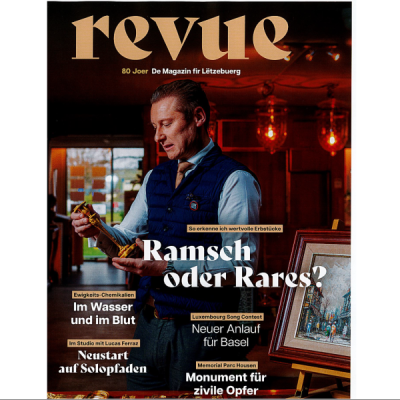30/01/2025, 09:30
A Treasure in Your Attic? Interview for Revue Magazine
The long-forgotten grandfather’s clock, the silver cutlery from grandmother’s estate, or the painting that has adorned the living room wall for years: behind some heirlooms lies a real treasure. How can you tell if you have a valuable artwork at home or just a trinket? Expert Adrien Denoyelle reveals how.
“Take your time to look closely,” advises Adrien Denoyelle. Raised in a family of antique dealers, this French native grew up with a passion for artistic objects. His father has been an antique dealer and expert in 18th-century furniture for over 45 years and is also a major collector.
The son, for his part, has specialized in the comprehensive evaluation of art and furniture from the 18th, 19th, and 20th centuries after working in several galleries. As a certified art expert and member of the "Chambre des Experts" in Luxembourg, Denoyelle is often called upon to evaluate objects from private estates for appraisal and resale. On several occasions, he has discovered real treasures, as he shares during a visit to his studio in Stadtbredimus.
Among his areas of expertise is the comprehensive management of private estates. He and his team at "Lux Auction Luxembourg" have encountered many surprises, like the case of a man who, by chance, brought his grandfather's clock for appraisal. A clock expert from Paris initially estimated the heirloom at 80,000 to 90,000 euros. The clock, made in 1946 and bought in 1947, with a large dial and hands made of 18-carat gold, was eventually sold at auction for 250,000 euros. It was purchased by the Patek Philippe Museum in Geneva.
The Expert Himself
These special cases impressively show that it’s worth taking a closer look at home. The author of these lines also found, while rummaging, a painting that her father-in-law had brought back from a vacation in France. Representing many similar pieces found in Luxembourg households, this artwork will serve as an example for Denoyelle to demonstrate how a layperson can get a first impression of the value of an artwork.
Regarding the painting, the expert first advises checking the technique. If oil paints were used, it’s a first sign of value. Lithographs, on the other hand, are often prints and less valuable. "Here, the oil paints convince me. They’re on canvas, attached to a wooden frame with nails. In my opinion, this is an original painting." he concludes. Then, the expert looks for a signature. Luckily, it is clearly visible, although the artist seems to be lesser-known.
To learn more about artworks and their creators, experts use specialized databases that are only accessible to professionals. "We search in special databases that are globally connected and available only to experts. These provide information on particular works, the popularity of artists, and sales of objects by specific artists in other countries. Every auction house worldwide is required to enter the details of a sale into these databases," the expert explains.
"We work like detectives," says Adrien Denoyelle. Once the information on style, subject, and the general reputation of the artist is gathered, experts set a price range. In this case, it is between 200 and 400 euros, as the artist is not a renowned master.
The Devil is in the Details
Many people have inherited cutlery at home, says the expert while examining a fork closely. Most people are convinced it’s real silver, but this is rarely the case. "To know if it's real silver, check the hallmark on each piece, the head of the goddess Minerva. If the hallmark is missing and instead a number is printed, it indicates alloyed or silver-plated metal," the expert explains.
To assess the details, it's important to take your time if you want to find out whether an item is a valuable rarity. As an example, Denoyelle shows two candlesticks from his personal collection. They are heavy, finely crafted, and shine in gold. "These candlesticks are 200 years old. You can see that the molten material was poured into a mold, then hand-worked after cooling." The indication of craftsmanship also lies in the detailed depiction of the faces. The finer their execution, the better, he says while unscrewing the top part of one of the candlesticks.
Supposed Dust Catcher
The expert also takes care of inheritances, including assessing each object. During one such clearance, an employee discovered a metal sculpture hidden in a corner of the house. Since the heir didn’t want to keep it, the sculpture, about 1.50 meters high, was taken to the company’s headquarters for closer inspection. "We discovered that the sculpture was signed by Bernar Venet and had a huge surprise." The French sculptor is well-known, especially in Luxembourg, especially for his monumental sculpture "Arc Majeur" along the E411 motorway in Belgium.
Expert and Collector Meetings
Art and antique lovers will find what they are looking for at the "Antiques & Art Fair" at the Luxexpo. From January 29 to February 2, around 100 professional exhibitors from seven countries will participate in the anniversary edition of the fair. All items on display are verified for authenticity by an external jury. "In Luxembourg, we place a particularly high value on protecting potential buyers from forgeries," emphasizes the expert. Indeed, art lovers are guided less by price and more by their connection to the work. Therefore, offering them authentic collector's items is all the more important.
Found a treasure? Those who have special objects at home and want to have them appraised can get advice at the trade fair in Hall 2 of the Luxexpo. "It's enough to bring a photo of the object or the work itself," says Adrien Denoyelle. All information about the "Antiques & Art Fair" is available at thebox.lu.
